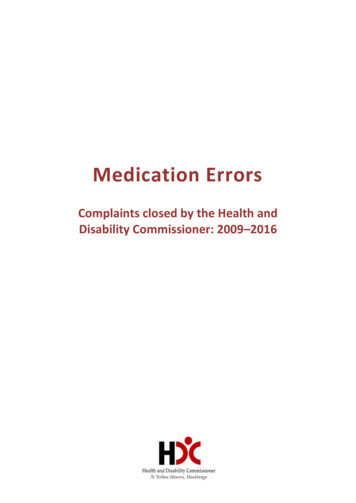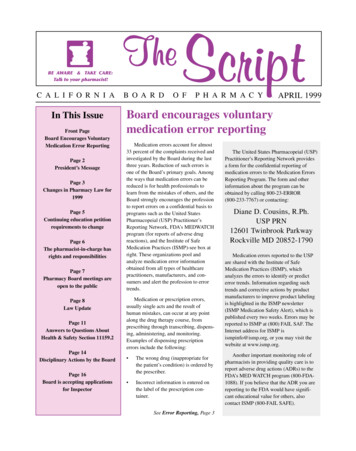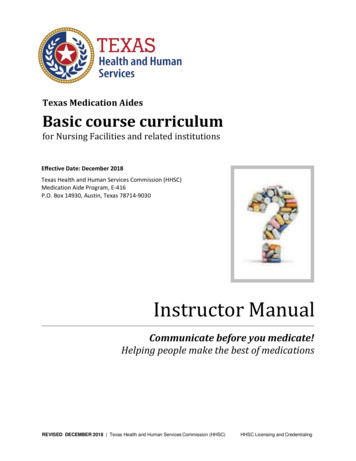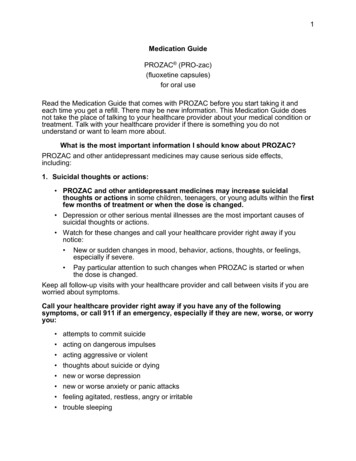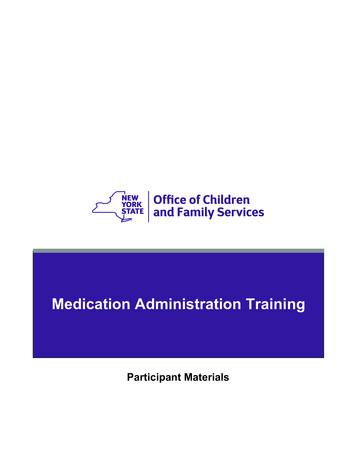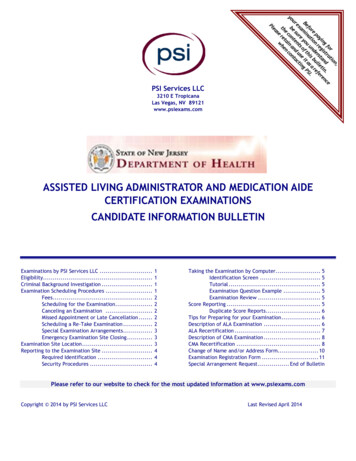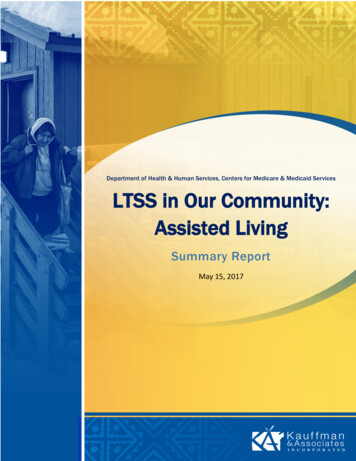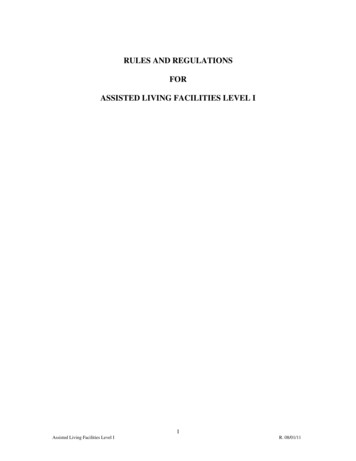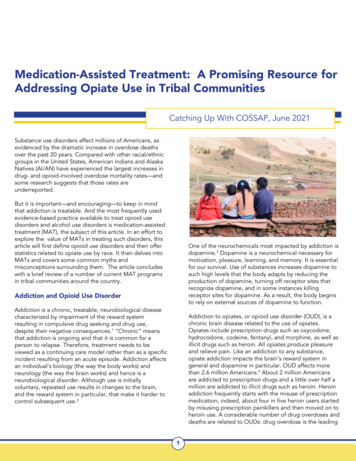
Transcription
Medication-Assisted Treatment: A Promising Resource forAddressing Opiate Use in Tribal CommunitiesCatching Up With COSSAP, June 2021Substance use disorders affect millions of Americans, asevidenced by the dramatic increase in overdose deathsover the past 20 years. Compared with other racial/ethnicgroups in the United States, American Indians and AlaskaNatives (AI/AN) have experienced the largest increases indrug- and opioid-involved overdose mortality rates—andsome research suggests that those rates areunderreported.But it is important—and encouraging—to keep in mindthat addiction is treatable. And the most frequently usedevidence-based practice available to treat opioid usedisorders and alcohol use disorders is medication-assistedtreatment (MAT), the subject of this article. In an effort toexplore the value of MATs in treating such disorders, thisarticle will first define opioid use disorders and then offerstatistics related to opiate use by race. It then delves intoMATs and covers some common myths andmisconceptions surrounding them. The article concludeswith a brief review of a number of current MAT programsin tribal communities around the country.One of the neurochemicals most impacted by addiction isdopamine.3 Dopamine is a neurochemical necessary formotivation, pleasure, learning, and memory. It is essentialfor our survival. Use of substances increases dopamine tosuch high levels that the body adapts by reducing theproduction of dopamine, turning off receptor sites thatrecognize dopamine, and in some instances killingreceptor sites for dopamine. As a result, the body beginsto rely on external sources of dopamine to function.Addiction and Opioid Use DisorderAddiction is a chronic, treatable, neurobiological diseasecharacterized by impairment of the reward systemresulting in compulsive drug seeking and drug use,despite their negative consequences.1 “Chronic” meansthat addiction is ongoing and that it is common for aperson to relapse. Therefore, treatment needs to beviewed as a continuing care model rather than as a specificincident resulting from an acute episode. Addiction affectsan individual’s biology (the way the body works) andneurology (the way the brain works) and hence is aneurobiological disorder. Although use is initiallyvoluntary, repeated use results in changes to the brain,and the reward system in particular, that make it harder tocontrol subsequent use.2Addiction to opiates, or opioid use disorder (OUD), is achronic brain disease related to the use of opiates.Opiates include prescription drugs such as oxycodone,hydrocodone, codeine, fentanyl, and morphine, as well asillicit drugs such as heroin. All opiates produce pleasureand relieve pain. Like an addiction to any substance,opiate addiction impacts the brain’s reward system ingeneral and dopamine in particular. OUD affects morethan 2.6 million Americans.4 About 2 million Americansare addicted to prescription drugs and a little over half amillion are addicted to illicit drugs such as heroin. Heroinaddiction frequently starts with the misuse of prescriptionmedication; indeed, about four in five heroin users startedby misusing prescription painkillers and then moved on toheroin use. A considerable number of drug overdoses anddeaths are related to OUDs: drug overdose is the leading1
Medication-Assisted Treatment: A Promising Resource for Addressing Opiate Usein Tribal CommunitiesCatching Up With COSSAP, June 2021cause of accidental death in the United States, and overhalf of those drug overdoses can be contributed to opiatesalone. Although prescription opiates had previously beenthe leading cause of overdose deaths, more recently,heroin and synthetic opiates such as fentanyl account forthe most overdose deaths.5combined with naloxone (Suboxone), it relieves symptomsof opiate withdrawal and also reduces the likelihood ofabuse of the medication. Suboxone can be prescribedonly by physicians who have completed special training toprescribe buprenorphine.10MAT is usually considered for clients with a moderate orsevere alcohol use disorder or for those struggling withcravings and relapse. Medications that are mostcommonly prescribed and approved for treating alcoholuse disorders include disulfiram (Antabuse), which causes asignificant physical reaction when alcohol is consumed;naltrexone (Vivitrol/Revia); and acamprosate (Campral),which supports the rebalancing of neurotransmitters GABAand glutamate.11For people facing an OUD, relapse rates are high. Withthe use of counseling or behavioral therapies alone in thetreatment of opiate addiction, relapse rates after a year oftreatment sometimes are as high as 90 percent.6 Yet theserelapse rates are cut in half when medication is added totreatment. Combining medication and treatment istherefore the most effective way of treating opiateaddiction. This is especially true for people with limitedsocial support and stability, trauma and who haveexperienced adverse childhood experiences.Unfortunately, not all who need treatment receive it, andcurrent research estimates that nearly 80 percent of thosewith an OUD do not receive treatment.7Data Specific to American Indians/Alaskan NativesAmerican Indians/Alaskan Natives (AI/AN) have higherrates of substance use disorders than any other race.Three times as many AI/ANs are diagnosed with substanceuse disorders compared with white Americans.12 Twice asmany require treatment for addiction compared with anyother racial and ethnic group, but fewer receive treatment.Tribal communities also have the highest rates of alcoholrelated deaths as well as a higher opioid mortality ratethan any other racial and ethnic group. Deaths of AI/ANsvary significantly by state, with the highest rates ofoverdose deaths in Minnesota and Washington State.Medication-Assisted TreatmentMedication-assisted treatment (MAT) is defined as the useof a combination of medication and counseling orbehavioral therapies in the treatment of addiction. Thesemedications serve to support the production of dopamine,normalize brain chemistry, reduce craving and withdrawal,and support the restoration of normal physiology to abody that has been impacted by addiction. Further, theydo not have the same negative or euphoric effect that thesubstance of abuse has. MATs are most frequently used inthe treatment of OUD and alcohol use disorder.8Unfortunately, implementation of MATs is significantlylower in tribal communities than in the general population.A survey of treatment providers serving AI/AN clientsfound that only 28 percent offer MATs.13 This could bedue to numerous barriers, including structural barriers suchas issues related to funding, transportation, and access toservices; community barriers such as stigma andmisperceptions around MATs; organizational barriers suchas inability to recruit qualified providers particularly inremote areas; and individual barriers such as fear ormistrust of MATs and a mismatch between MATs and amore holistic healing tradition common in AI/ANcommunities.14,15Combining medication with behavior therapies is the mosteffective method of treating OUDs.9 The different types ofmedications used to treat OUDs vary in their targetpopulation and effectiveness, so a thorough assessmentand a medical plan are needed before a regimen isstarted. Medications used include naltrexone(Vivitrol/Revia), which blocks opiate receptors, therebylimiting the reward circuity activated when drinking orcraving, and is available as a monthly injectable and canbe prescribed by anyone licensed to prescribemedications; methadone (Methadose/Diskets/Dolophine),which acts as an opiate agonist and can only be dispensedby certified and approved opioid treatment programs; andbuprenorphine (Butrans/Buprenex), which relieves thesymptoms of opiate withdrawal. When buprenorphine isMyths and MisconceptionsMATs are just substituting one drug for another.Medications used in MATs differ from addictive substances(alcohol or opiates) in terms of intensity and effect. The2
Medication-Assisted Treatment: A Promising Resource for Addressing Opiate Usein Tribal CommunitiesCatching Up With COSSAP, June 2021People would just sell their medications to fund theirhabits.dosage provided is not intense enough for an individual toget the same high he or she would get from a substanceof choice. Further, the effect is not euphoria but instead areduction in withdrawal symptoms and cravings. Somemedications reduce the euphoric effect of the substanceof choice if they are consumed during a course of MAT.Finally, addiction is defined as compulsive use of a drugdespite negative consequences and not as physiologicaldependence (needing daily medication to stay healthy,similar to individuals with heart disease, diabetes,hypothyroidism, etc.).16Diversion of medications used in MATs is uncommon.When it does happen, the person buying the medication isusually using it to manage withdrawal, not for its euphoriceffect.24MATs are expensive.MATs are both cost-effective and cost-beneficial, resultingin improved outcomes and reduced overall costs tosociety in terms of emergency room visits, overdosedeaths, and criminal involvement. In one study focused onindigenous peoples, MATs reduced the likelihood ofoverdose by 50 percent compared with a nonmedicatedcontrol group and had an overall social cost of less thanhalf compared with those not on MATs.17,18MATs are not effective.MAT Programs in Tribal CommunitiesIn several research studies, MATs appear to be moreeffective in the treatment of OUDs than counseling alone.MATs also significantly reduce the need for inpatientdetoxification services and provide a more comprehensiveand individualized program, comprising medication andbehavioral therapy, to address the needs of the wholeperson. When compared with a placebo and with nomedication, MATs reduce illicit opioid use, increase thelikelihood of individuals staying in treatment, and reducethe risk of overdose. MATs also lower the risk ofcontracting HIV and hepatitis C.19,20,21Given the significant rates of opioid abuse in tribalcommunities, federal, state, local, and tribal jurisdictionshave all recognized the need to identify gaps in tribalservices and develop appropriate intervention strategies.While MAT can be an effective standalone intervention,specific concerns have been identified related to theeffectiveness of using strictly Western criminal justice,mental health, and medical approaches for the AI/ANpopulation. As a result, efforts are ongoing to addressopioid and other substance abuse through the blending ofthese approaches with culturally specific prevention,treatment, and recovery services such as healing-towellness courts, indigenous healing services, talkingcircles, cultural connection and rituals, and efforts toaddress historical and inter-generational trauma.MATs are a lifelong sentence.MATs are used to serve as part of a treatment plan totarget the needs of the individual. They can therefore beused as a short-term methodology to medically managewithdrawal or as part of a long-term strategy to supportand maintain treatment.22The development of comprehensive, blended tribaltreatment and recovery programs has been initiatedthrough a variety of government agencies and fundingmechanisms. As part of Comprehensive Opioid, Stimulantand Substance Abuse Program (COSSAP) fundingawarded to tribal grantees by the Bureau of JusticeAssistance (BJA), tribes are able to develop andimplement MAT programs and increase tribal communityMATs are not safe.When taken as prescribed, MATs are both safe andeffective. They increase the success of outpatienttreatment and reduce the likelihood of relapse andoverdose.233
Medication-Assisted Treatment: A Promising Resource for Addressing Opiate Usein Tribal CommunitiesCatching Up With COSSAP, June 2021members’ access to MATs. Last year, the Substance Abuseand Mental Health Services Administration also awardedgrants to more than 125 programs serving tribalcommunities. These grants were a part of the TribalOpioid Response funding and ranged between 100,000and several million dollars. The objectives of the projectsranged from reducing unmet treatment needs and opioidoverdose-related deaths for American Indians toincreasing prevention and education efforts and access tochemical dependency treatment.issues through the Makah Tribal Healing to WellnessCourt. Tribal members are eligible for this program basedon a deferred sentence, term of probation, or a voluntaryreferral. Wraparound case management services include achemical dependency evaluation and both inpatient andoutpatient treatment, access to MAT, self-help groups,and recovery coaches, development of protective factorssuch as employment and education, and participation incultural events. In addition, the Neah Bay Public SafetyDepartment includes an Adult Corrections Center thatprovides services to this population.A number of states, including Alaska, California, Montana,and Nevada, have utilized federal funding to implementculturally specific interventions in conjunction with MAT forall tribes within their borders. In addition, these serviceshave been supported at the intertribal organizational level,such as by the Northwest Portland Area Indian HealthBoard and the Intertribal Council of Michigan. Finally, anumber of individual tribes have worked to implementtreatment approaches, including MAT, with support fromtribal leadership by combining tribal and/or federalfunding, including the Jamestown S’Klallam Tribe, theSwinomish Indian Tribal Community, and the QuinaultIndian Community in Washington; the Modoc Nation andthe Cherokee Nation in Oklahoma; the Wabanaki Tribes inMaine; and the Lower Sioux Indian Community inMinnesota, among others.The FY2018 COSSAP grant project, which is still inprogress, has been focused on developing amultidisciplinary response team that comprises all tribalagencies and programs that address tribal substanceabuse issues, as well as law enforcement-assisted diversion(LEAD). The COSSAP program coordinator and casemanager assist in the Sisuk House Project (Oxford Stylerecovery homes) and have been requested to help theMakah Wellness Center MAT program to better serve theMakah people and the Neah Bay Community.The FY2020 COSSAP project includes continuation of theLEAD program development, implementation, evaluation,and program analysis. In addition, it will expand MATservices to the Neah Bay Public Safety Adult CorrectionsCenter through the development of program guidelines,review, implementation, and evaluation.Native American tribes have experienced a number ofchallenges in implementing comprehensive, tribal-specifictreatment programs, including MAT, such as difficulties inlocating a suitable facility site in the face of local nontribalcommunity resistance; racial discrimination andstereotyping; lack of tribal community support or culturalawareness; and resource limitations. For example, theJamestown S’Klallam Tribe has been seeking communitysupport for its recently purchased tribal treatment facilitysite against significant opposition from the localjurisdiction. And as part of its effort to implement a tribalMAT project, the state of California chose to conduct aneeds assessment to determine how to increasecommunity support to address substance abuse in tribalcommunities, specifically identifying the need for culturallycentered care in AI/AN treatment facilities.Another example of a successful tribal MAT program, theSouthern Ute Tribal Health Center, provides MAT to tribalmembers who primarily have alcohol abuse disorders, inparticular repeat offenders, based on referrals from thetribal wellness court, which features oversight by a judgeand tribal probation services. The local family treatmentcourt also intervenes with this population in conjunctionwith social services to prevent criminal justice systeminvolvement. To enable access to MAT, a referral forassessment is made and a comprehensive evaluation iscompleted. Additional services can include psychologicalassessment and inpatient and outpatient treatmentservices. The Southern Ute Tribe currently has plans to useBJA Coordinated Tribal Assistance Solicitation (CTAS)grant funds for additional construction and remodeling ofthe clinic to expand capacity for a sober living facility.As an example of a specific tribal MAT programdevelopment, the Makah Tribe in Washington State isworking to implement new programming through FY2018and FY2020 COSSAP grants. The Makah Tribe providesservices to tribal members dealing with substance abuseA final example of the incorporation of MAT into acomprehensive approach to substance abuse is evident atthe Didgwalic Wellness Center, which is owned and4
Medication-Assisted Treatment: A Promising Resource for Addressing Opiate Usein Tribal CommunitiesCatching Up With COSSAP, June 2021operated by the Swinomish Indian Tribal Community andprovides counseling, medication, primary care, and socialservices to Native Americans with substance abusedisorders. The treatment model was developed with inputfrom the tribal leadership of the Swinomish, clients andtheir families, and the community at large. Forparticipants, the comprehensive individualized treatmentplan can include MAT. The program has won a number ofinnovation awards by combining treatment with evidencebased medicine, as well as tribal community knowledgeand culturally competent care. The program providesservices for both natives and nonnatives. The WellnessCenter website features a number of videos describing theprogram, which can be found e opioid epidemic continues to affect a staggeringnumber of people in this country, with a significant impactbeing felt in AI/AN communities. The need to take actionis clear, and the research on MATs as an effectiveapproach is established. However, much is needed toimplement MATs in tribal communities at scale, and itstarts with bridging the gap between traditional tribalwisdom and what is known about MATs so that the lattercan be delivered in a way that is congruent with traditionalhealing and wellness practices. Barriers to implementation,be they systemic, organizational, community, or individual,need to be addressed. Integrating MATs into what alreadyworks in tribal communities might help further support thetreatment of OUDs and reduce their negativeconsequences.5
Medication-Assisted Treatment: A Promising Resource for Addressing Opiate Usein Tribal CommunitiesCatching Up With COSSAP, June 20211. Volkow, N. D., & Boyle, M. (2018). Neuroscience ofaddiction: Relevance to prevention andtreatment. American Journal of Psychiatry, 175(8), 729740.2. NIDA. 2018, June 6. Understanding Drug Use andAddiction Drug Facts. Retrieved ts/understanding-drug-use-addiction on 2020, September12.13. Venner, K. L., Donovan, D. M., Campbell, A. N.,Wendt, D. C., Rieckmann, T., Radin, S. M., &Rosa, C. L., et al. (2018). Future directions formedication-assisted treatment for opioid use disorderwith American Indian/Alaska Natives. Addictivebehaviors, 86, 111–117.14. Ibid.3. Koob, G. F., & Volkow, N. D. (2016). Neurobiology ofaddiction: A neurocircuitry analysis. The LancetPsychiatry, 3(8), 760–773.15. Rieckmann, T., Moore, L., Croy, C., Aarons, G. A., &Novins, D. K. (2017). National overview of medicationassisted treatment for American Indians and AlaskaNatives with substance use disorders. PsychiatricServices, 68(11), 1136–1143.4. Connery, H. S. (2015). Medication-assisted treatmentof opioid use disorder: review of the evidence andfuture directions. Harvard review of psychiatry, 23(2),63–75.16. Wakeman, S. E., & Barnett, M. L. (2018). Primary careand the opioid-overdose crisis—buprenorphine mythsand realities. New England Journal of Medicine,379(1), 1–4.5. Volkow, N. D., Jones, E. B., Einstein, E. B., & Wargo,E. M. (2019). Prevention and treatment of opioidmisuse and addiction: a review. JAMApsychiatry, 76(2), 208–216.17. Krebs, E., Enns, B., Evans, E., Urada, D., Anglin, M. D.,Rawson, R. A. & Nosyk, B., et al. (2018). Costeffectiveness of publicly funded treatment of opioiduse disorder in California. Annals of internal medicine,168(1), 10–19.6. Substance Abuse and Mental Health ServicesAdministration. (2018). Medications for opioid usedisorder. Treatment Improvement Protocol (TIP) Series63, Full Document.18. Murphy, S., Polsky, D., Meisel, Z., & Mitchell, J. (2018).Show me the money: Economic evaluations of opioiduse disorder interventions. LDI Issue Briefs.7. Wakeman, S. E., & Barnett, M. L. (2018). Primary careand the opioid-overdose crisis—buprenorphine mythsand realities. New England Journal of Medicine,379(1), 1–4.19. Volkow, N. D., Jones, E. B., Einstein, E. B., & Wargo,E. M. (2019). Prevention and treatment of opioidmisuse and addiction: a review. JAMA psychiatry,76(2), 208–216.8. Substance Abuse and Mental Health ServicesAdministration. (2018). Medications for opioid usedisorder. Treatment Improvement Protocol (TIP) Series63, Full Document.20. Connery, H. S. (2015). Medication-assisted treatmentof opioid use disorder: Review of the evidence andfuture directions. Harvard review of psychiatry, 23(2),63–75.9. Connery, H. S. (2015). Medication-assisted treatmentof opioid use disorder: Review of the evidence andfuture directions. Harvard review of psychiatry, 23(2),63–75.21. Substance Abuse and Mental Health ServicesAdministration. (2018). Medications for opioid usedisorder. Treatment Improvement Protocol (TIP) Series63, Full Document.10. Ibid.22. Ibid.11. Ibid.23. Wakeman, S. E., & Barnett, M. L. (2018). Primary careand the opioid-overdose crisis—buprenorphine mythsand realities. New England Journal of Medicine,379(1), 1–4.12. Rieckmann, T., Moore, L., Croy, C., Aarons, G. A., &Novins, D. K. (2017). National overview of medicationassisted treatment for American Indians and AlaskaNatives with substance use disorders. PsychiatricServices, 68(11), 1136–1143.24. Ibid.
opiate addiction impacts the brain's reward system in general and dopamine in particular. OUD affects more than 2.6 million Americans. 4 . About 2 million Americans are addicted to prescription drugs and a little over half a million are addicted to illicit drugs such as heroin. Heroin addiction frequently starts with the misuse of prescription

